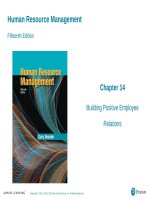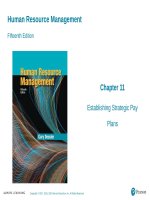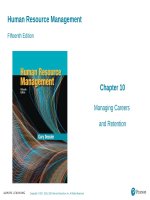Test bank solution of human resource management 15e by gary dessler 2017 chapter 03
Bạn đang xem bản rút gọn của tài liệu. Xem và tải ngay bản đầy đủ của tài liệu tại đây (269.8 KB, 47 trang )
Human Resource Management, 15e (Dessler)
Chapter 3 Human Resource Management Strategy and Analysis
1) ________ defines the nature of the company's business in terms of how it will match its
internal strengths and weaknesses with its external opportunities and threats in order to maintain
a competitive position.
A) Financial auditing
B) Strategic planning
C) Employee benchmarking
D) Employee testing
Answer: B
Explanation: B) Strategic planning is the company's overall planning for how it will match its
internal strengths and weaknesses with its external opportunities and threats in order to maintain
a competitive position.
Difficulty: Moderate
Chapter: 3
Objective: 1
AACSB: Analytical Thinking
Learning Outcome: 3.1 Explain with examples each of the eight steps in the strategic
management process.
2) ________ involves setting objectives, making forecasts, reviewing alternative courses of
action, evaluating options and implementing the plan.
A) The management planning process
B) Financial auditing
C) Employee testing
D) Employee benchmarking
Answer: A
Explanation: A) The basic management planning process involves setting objectives, making
forecasts, reviewing alternative courses of action, evaluating options and implementing the plan.
Planning is always goal-directed.
Difficulty: Moderate
Chapter: 3
Objective: 1
AACSB: Analytical Thinking
Learning Outcome: 3.1 Explain with examples each of the eight steps in the strategic
management process.
1
Copyright © 2017 Pearson Education, Inc.
3) What is the first step in the basic planning process?
A) evaluating the possible alternatives
B) implementing a course of action
C) setting an objective
D) comparing options
Answer: C
Explanation: C) The first step of management planning is to set an objective or a goal.
Difficulty: Moderate
Chapter: 3
Objective: 1
AACSB: Analytical Thinking
Learning Outcome: 3.1 Explain with examples each of the eight steps in the strategic
management process.
4) Which of the following is NOT part of the basic managerial planning?
A) evaluation of best options
B) establishment of clear objectives
C) implementation of the plan
D) building corporate hierarchies
Answer: D
Explanation: D) The basic management planning process involves setting objectives, making
basic planning forecasts, reviewing alternative courses of action, evaluating which options are
best and then choosing and implementing the plan. However, managerial planning is hindered by
the hierarchy of a corporation, which requires that plans meet budgetary requirements and match
the long-term goals of the firm.
Difficulty: Moderate
Chapter: 3
Objective: 1
AACSB: Analytical Thinking
Learning Outcome: 3.1 Explain with examples each of the eight steps in the strategic
management process.
5) Which term indicates the course of action for getting from where you are to where you want to
go?
A) goal
B) plan
C) proposition
D) assessment
Answer: B
Explanation: B) A plan shows the course of action for getting from where you are to where you
want to go—in other words, to the goal. Planning is always "goal-directed."
Difficulty: Easy
Chapter: 3
Objective: 1
AACSB: Analytical Thinking
Learning Outcome: 3.1 Explain with examples each of the eight steps in the strategic
management process.
2
Copyright © 2017 Pearson Education, Inc.
6) What is a company's plan for how it will match its internal strengths and weaknesses with
external opportunities and threats to maintain a competitive advantage?
A) strategic plan
B) situation analysis
C) SWOT analysis
D) tactical plan
Answer: A
Explanation: A) A strategic plan is a firm's plan for assessing internal strengths and weaknesses
with external opportunities and threats. The essence of strategic planning involves asking,
"Where are we now as a business and where do we want to be?" Managers then develop specific
strategies for taking a firm where it wants to be.
Difficulty: Moderate
Chapter: 3
Objective: 1
AACSB: Analytical Thinking
Learning Outcome: 3.1 Explain with examples each of the eight steps in the strategic
management process.
7) A course of action that a firm can pursue to achieve its strategic aims is known as a ________.
A) vision
B) goal
C) strategy
D) mission
Answer: C
Explanation: C) A strategy is a course of action taken by a firm to achieve strategic aims.
Difficulty: Easy
Chapter: 3
Objective: 1
AACSB: Analytical Thinking
Learning Outcome: 3.1 Explain with examples each of the eight steps in the strategic
management process.
3
Copyright © 2017 Pearson Education, Inc.
8) Strategic management is best defined as the process of identifying and executing the
organization's strategic plan by matching the company's capabilities with its ________.
A) environmental demands
B) competitive standards
C) natural resources
D) hierarchical skills
Answer: A
Explanation: A) Strategic management is the process of identifying and executing the
organization's strategic plan by matching the company's capabilities with the demands of its
environment. Industry standards, resources, and corporate hierarchies are less relevant.
Difficulty: Easy
Chapter: 3
Objective: 1
AACSB: Analytical Thinking
Learning Outcome: 3.1 Explain with examples each of the eight steps in the strategic
management process.
9) All of the following are steps involved in the strategic management process EXCEPT
________.
A) evaluating the firm's internal and external situation
B) asking, "Where are we now as a business?"
C) formulating a new business direction
D) offshoring low-skill jobs
Answer: D
Explanation: D) While offshoring low-skill jobs may be a strategy for some firms to lower
expenditures, it is not a specific step involved in the strategic management process.
Difficulty: Moderate
Chapter: 3
Objective: 1
AACSB: Analytical Thinking
Learning Outcome: 3.1 Explain with examples each of the eight steps in the strategic
management process.
10) What is the first step in the strategic management process?
A) formulating a strategy
B) asking, "Where are we now as a business?"
C) evaluating the strategic plan
D) implementing an environmental scan
Answer: B
Explanation: B) The first step in the strategic planning process is asking, "Where are we now as
a business?"
Difficulty: Moderate
Chapter: 3
Objective: 1
AACSB: Analytical Thinking
Learning Outcome: 3.1 Explain with examples each of the eight steps in the strategic
management process.
4
Copyright © 2017 Pearson Education, Inc.
11) Which of the following is a simple guide used to compile relevant information about a
company's environment including economic, competitive, and political trends that may affect a
firm?
A) workforce requirement matrix
B) environmental scan worksheet
C) external resource system table
D) potential globalization network
Answer: B
Explanation: B) Environmental scan worksheets are a guide for compiling information about the
company's environment. This includes the economic, competitive, and political trends that may
affect the company.
Difficulty: Easy
Chapter: 3
Objective: 1
AACSB: Analytical Thinking
Learning Outcome: 3.1 Explain with examples each of the eight steps in the strategic
management process.
12) John wants to perform external and internal audits as part of the strategic management
process. What is a frequently used tool to organize relevant information on positive and negative
aspects of the company and environment?
A) BCG matrix
B) QSPM matrix
C) SWOT chart
D) EPS/EBIT table
Answer: C
Explanation: C) The SWOT chart is a tool frequently used by managers who are responsible for
performing external and internal audits. Managers use it to compile and organize the company
strengths, weaknesses, opportunities, and threats.
Difficulty: Moderate
Chapter: 3
Objective: 1
AACSB: Application of Knowledge
Learning Outcome: 3.1 Explain with examples each of the eight steps in the strategic
management process.
5
Copyright © 2017 Pearson Education, Inc.
13) Which of the following provides a summary of a firm's intended direction and shows, in
broad terms, "what we want to become"?
A) mission statement
B) strategic plan
C) vision statement
D) marketing plan
Answer: C
Explanation: C) A firm's vision statement is a general statement about the intended direction of
the firm and what the business should look like in the future.
Difficulty: Easy
Chapter: 3
Objective: 1
AACSB: Analytical Thinking
Learning Outcome: 3.1 Explain with examples each of the eight steps in the strategic
management process.
14) The sales director at WebMD is calculating annual sales revenue targets and the number of
new medical-related content providers that the firm needs to maintain a competitive advantage.
In which step of the strategic management process is the sales director involved?
A) evaluating the firm's internal and external strengths
B) defining the business and its mission
C) choosing specific strategies or courses of action
D) evaluating the strategic plan
Answer: C
Explanation: C) The sales director is in the process of translating the firm's mission, which is to
maintain a competitive advantage, choosing specific strategies or courses of action. This step is
the fifth one in the strategic process, and it occurs after the manager makes a strategic choice.
Difficulty: Hard
Chapter: 3
Objective: 1
AACSB: Application of Knowledge
Learning Outcome: 3.1 Explain with examples each of the eight steps in the strategic
management process.
6
Copyright © 2017 Pearson Education, Inc.
15) The ________ of the California Energy Commission indicates that the organization assesses
and acts through public and private partnerships to improve energy systems that promote a strong
economy and a healthy environment.
A) mission statement
B) strategic plan
C) code of ethics
D) vision statement
Answer: A
Explanation: A) A mission statement addresses the question, "What business are we in?"
Mission statements explain the scope of an organization's product or services, and they may also
address issues of vertical integration, geographic coverage, and competitive advantage.
Difficulty: Hard
Chapter: 3
Objective: 1
AACSB: Application of Knowledge
Learning Outcome: 3.1 Explain with examples each of the eight steps in the strategic
management process.
16) Goals are initiated by the bottom level of an organization according to the hierarchy of goals
approach to strategic planning.
Answer: FALSE
Explanation: Under the hierarchy of goals approach to strategic planning, goals are set at the top
of a company by the president or CEO. Goals then flow downward to the lowest-ranked
managers and employees.
Difficulty: Moderate
Chapter: 3
Objective: 1
AACSB: Analytical Thinking
Learning Outcome: 3.1 Explain with examples each of the eight steps in the strategic
management process.
17) Steps in the basic management planning process include setting objectives, reviewing
alternative courses of action, and evaluating which options are best.
Answer: TRUE
Explanation: The basic management planning process consists of five steps: setting objectives,
making basic planning forecasts, reviewing alternative courses of action, evaluating which
options are best, and then choosing and implementing your plan planning process.
Difficulty: Moderate
Chapter: 3
Objective: 1
AACSB: Analytical Thinking
Learning Outcome: 3.1 Explain with examples each of the eight steps in the strategic
management process.
7
Copyright © 2017 Pearson Education, Inc.
18) Strategy is a course of action.
Answer: TRUE
Explanation: Strategy is a course of action the company can pursue to achieve its strategic aims.
Difficulty: Easy
Chapter: 3
Objective: 1
AACSB: Analytical Thinking
Learning Outcome: 3.1 Explain with examples each of the eight steps in the strategic
management process.
19) A mission statement is a general statement of a company's intended direction that evokes
emotional feelings in the organization's members.
Answer: FALSE
Explanation: A firm's mission statement answers the question, "What business are we in?"
Managers use mission statements to pinpoint whether and how the firm will vertically integrate,
as well as the firm's product scope, geographic coverage, and competitive advantage.
Difficulty: Easy
Chapter: 3
Objective: 1
AACSB: Analytical Thinking
Learning Outcome: 3.1 Explain with examples each of the eight steps in the strategic
management process.
20) A vision statement is broader and more future-oriented than a mission statement.
Answer: TRUE
Explanation: The vision statement is a general statement of the firm's intended direction and
broadly indicates what the firm wants to become. Vision statements focus on the future while
mission statements address what the business does.
Difficulty: Moderate
Chapter: 3
Objective: 1
AACSB: Analytical Thinking
Learning Outcome: 3.1 Explain with examples each of the eight steps in the strategic
management process.
21) Strategic management focuses more on translating a mission into goals than on the functions
of organizing, staffing, and controlling.
Answer: TRUE
Explanation: Strategic management is the process of identifying and executing the
organization's strategic plan by matching the company's capabilities with the demands of its
environment.
Difficulty: Moderate
Chapter: 3
Objective: 1
AACSB: Analytical Thinking
Learning Outcome: 3.1 Explain with examples each of the eight steps in the strategic
management process.
8
Copyright © 2017 Pearson Education, Inc.
22) Why is strategic planning important to managers? Explain the importance of setting
hierarchical goals.
Answer: Strategic planning is important to managers because in well-run companies the goals
from the very top of the organization downward should form a more-or-less unbroken chain (or
"hierarchy") of goals. These goals, in turn, should be guiding what everyone does. Management
creates a hierarchy or chain of departmental goals, from the top down to the lowest-ranked
managers, and even employees. Then, if everyone does his or her job—if each salesperson sells
his or her quota, and the sales manager hires enough good salespeople, and the HR manager
creates the right incentive plan, and the purchasing head buys enough raw materials—the
company and the CEO should also accomplish the overall, company-wide strategic goals. You
could therefore say with great certainty that without a clear plan at the top, no one in the
company would have the foggiest notion of what to do. At best, you'd all be working at crosspurposes.
Difficulty: Moderate
Chapter: 3
Objective: 1
AACSB: Analytical Thinking
Learning Outcome: 3.1 Explain with examples each of the eight steps in the strategic
management process.
9
Copyright © 2017 Pearson Education, Inc.
23) What is strategic management? List and explain each step in the strategic management
process.
Answer: Strategic management is the process of identifying and executing the organization's
mission, by matching the organization's capabilities with the demands of its environment. The
steps are as follows:
Step 1: Where are we now as a business?—Here the manager defines the company's current
business and mission. Specifically, what products do we sell, where do we sell them, and how do
our products or services differ from our competitors'?
Step 2: The second step is to ask, "Are we in the right business given our strengths and
weaknesses and the challenges that we face?" To answer this, managers "audit" or study both the
firm's environment and the firm's internal strengths and weaknesses. Prudent managers
periodically assess what's happening in their environments. You need to audit the firm's
environment and strengths and weaknesses. You can use the environmental scanning worksheet
or the SWOT chart.
Step 3: Decide what our new business should be in terms of what we sell, where we will sell it,
and how our products or services differ from competitors' products and services. This step is
where vision statements and mission statements are developed.
Step 4: Translate the desired new direction into strategic goals. At Ford, for example, what
exactly did making "Quality Job One" mean for each department in terms of how they would
boost quality? The answer was laid out in goals such as "no more than 1 initial defect per 10,000
cars."
Step 5: The manager chooses strategies—courses of action—that will enable the company to
achieve its strategic goals. For example, how should Ford pursue its goal of no more than 1
initial defect per 10,000 cars? Perhaps open two new high-tech plants and put in place new,
rigorous employee selection, training, and performance-appraisal procedures.
Step 6: Strategy execution, which means translating the strategies created into action. This means
actually hiring (or firing) people, building (or closing) plants, and adding (or eliminating)
products and product lines.
Step 7: The manager evaluates the results of his or her planning and execution. Things don't
always turn out as planned. All managers should periodically assess the progress of strategic
decisions.
Difficulty: Hard
Chapter: 3
Objective: 1
AACSB: Analytical Thinking
Learning Outcome: 3.1 Explain with examples each of the eight steps in the strategic
management process.
10
Copyright © 2017 Pearson Education, Inc.
24) Explain the difference between a firm's vision and its mission. How might these impact the
actions of an organization?
Answer: A company's vision is a general statement of the company's intended direction that
shows in broad terms what a company wants to become. A vision statement is future-oriented
while a mission statement is oriented in the present. Mission statements indicate what a company
is doing right now while vision statements are what a company strives to become. The vision
statement will impact how the organization plans for the future and what it focuses. The mission
statement is the plan for what the organization is doing in the current time period and day to day.
Difficulty: Hard
Chapter: 3
Objective: 1
AACSB: Analytical Thinking
Learning Outcome: 3.1 Explain with examples each of the eight steps in the strategic
management process.
25) A company's ________ strategy identifies the portfolio of businesses that comprise a firm
and the ways in which these businesses relate to each other.
A) functional
B) business unit
C) corporate-level
D) competitive
Answer: C
Explanation: C) Managers use three types of strategies for the three different levels of a
company. Corporate-level strategy identifies the portfolio of businesses that comprise a firm and
how these businesses relate to each other.
Difficulty: Easy
Chapter: 3
Objective: 2
AACSB: Analytical Thinking
Learning Outcome: 3.2 List with examples the main types of strategies.
26) A diversification corporate strategy implies that a firm will ________.
A) expand by adding new product lines
B) reduce the company's size to increase market share
C) save money by producing its own raw materials
D) increase profits by offering one popular product
Answer: A
Explanation: A) A diversification corporate strategy suggests that a firm will expand by adding
new product lines. For example, PepsiCo has diversified over the years by adding chips and
Quaker Oats to its product offerings.
Difficulty: Moderate
Chapter: 3
Objective: 2
AACSB: Analytical Thinking
Learning Outcome: 3.2 List with examples the main types of strategies.
11
Copyright © 2017 Pearson Education, Inc.
27) Harley-Davidson sells a line of boots, helmets, and leather jackets indicating that the firm is
pursuing which of the following strategies?
A) consolidation
B) geographic expansion
C) diversification
D) horizontal integration
Answer: C
Explanation: C) A diversification corporate strategy suggests that a firm will expand by adding
new product lines.
Difficulty: Moderate
Chapter: 3
Objective: 2
AACSB: Application of Knowledge
Learning Outcome: 3.2 List with examples the main types of strategies.
28) When Apple opened its own Apple stores, this was an example of ________.
A) market penetration
B) concentration
C) vertical integration
D) consolidation
Answer: C
Explanation: C) Vertical integration is a strategy that involves expansion through producing raw
material or selling product directly.
Difficulty: Easy
Chapter: 3
Objective: 2
AACSB: Application of Knowledge
Learning Outcome: 3.2 List with examples the main types of strategies.
29) Winchester Rugs operates a Web site called www.buyrugsdirect.com, so Winchester Rugs is
most likely using a strategy of ________.
A) consolidation
B) geographic expansion
C) vertical integration
D) concentration
Answer: C
Explanation: C) A vertical integration strategy means that a firm expands by producing its own
raw materials or, in the case of Winchester Rugs, selling its products directly instead of using a
retailer.
Difficulty: Moderate
Chapter: 3
Objective: 2
AACSB: Application of Knowledge
Learning Outcome: 3.2 List with examples the main types of strategies.
12
Copyright © 2017 Pearson Education, Inc.
30) Which of the following activities most likely indicates that a firm is implementing a vertical
integration strategy?
A) selling unprofitable divisions
B) producing raw materials
C) aggressively selling a new product
D) purchasing a competitor's firm
Answer: B
Explanation: B) Vertical integration strategies are methods used for expanding a firm that
typically include either selling products directly or producing raw materials rather than relying
on suppliers.
Difficulty: Easy
Chapter: 3
Objective: 2
AACSB: Application of Knowledge
Learning Outcome: 3.2 List with examples the main types of strategies.
31) The 2008 announcement by Starbucks that it would be closing approximately 600 of its
stores suggests the firm was using a ________ strategy.
A) consolidation
B) diversification
C) geographic expansion
D) vertical integration
Answer: A
Explanation: A) Starbucks is trying to reduce its size by eliminating some of its stores, so the
firm is using a strategy of consolidation. Diversification and geographic expansion would
involve expanding Starbucks with new products or opening stores in new locations rather than
closing stores.
Difficulty: Moderate
Chapter: 3
Objective: 2
AACSB: Application of Knowledge
Learning Outcome: 3.2 List with examples the main types of strategies.
13
Copyright © 2017 Pearson Education, Inc.
32) Sweet Leaf Tea, a Texas-based maker of bottled iced tea, is a small but fast-growing firm
that has gained a loyal following for its use of fresh, organic ingredients in its beverages.
Although beverage industry experts recommended that Sweet Leaf replace the organic cane
sugar and honey it uses with less costly high-fructose corn syrup, Sweet Leaf refused because of
the company's mission to provide a high-quality, organic beverage to consumers. The 11-year
old company has 50 employees, and its products are available in 30% of the U.S. market. Sweet
Leaf Tea recently received multi-million dollar investments which will enable the business to
expand its national presence.
Which of the following, if true, would best support the argument that Sweet Leaf Tea should
implement a corporate-level strategy of concentration?
A) Sweet Leaf Tea can develop a national name by adding new product lines, such as organic
snack foods and organic coffee.
B) Sweet Leaf Tea's marketing research indicates that customers would purchase the organic
beverages more frequently if the prices were lower.
C) Market data suggests that customers really only want the tea itself, not related products.
D) Sweet Leaf Tea's competitors primarily focus their marketing and distribution efforts on
regional grocery-store chains rather than big box national retailers.
Answer: C
Explanation: C) A corporate-level strategy of concentration means that Sweet Leaf would offer
one product or product line, usually in one market. The customers' interest in only the tea
suggests such a concentration is warranted.
Difficulty: Hard
Chapter: 3
Objective: 2
AACSB: Application of Knowledge
Learning Outcome: 3.2 List with examples the main types of strategies.
14
Copyright © 2017 Pearson Education, Inc.
33) Sweet Leaf Tea, a Texas-based maker of bottled iced tea, is a small but fast-growing firm
that has gained a loyal following for its use of fresh, organic ingredients in its beverages.
Although beverage industry experts recommended that Sweet Leaf replace the organic cane
sugar and honey it uses with less costly high-fructose corn syrup, Sweet Leaf refused because of
the company's mission to provide a high-quality, organic beverage to consumers. The 11-year
old company has 50 employees, and its products are available in 30% of the U.S. market. Sweet
Leaf Tea recently received multi-million dollar investments which will enable the business to
expand its national presence.
Which of the following, if true, would most likely undermine the argument that Sweet Leaf Tea
should implement a corporate-level strategy of vertical integration?
A) Sweet Leaf Tea lacks the facilities or knowledge to produce the raw ingredients for its
beverages.
B) Market research suggests that Sweet Leaf Tea customers primarily purchase only one flavor
of tea.
C) Most loyal customers of Sweet Leaf Tea purchase the beverage at neighborhood convenience
stores.
D) Sugar farmers used by Sweet Leaf Tea have agreed to a fixed price for the next five years so
that the company can keep prices low.
Answer: A
Explanation: A) A corporate-level strategy of vertical integration would require Sweet Leaf to
expand by either producing its own raw materials or selling its products directly. If the company
lacks the facilities and knowledge to produce raw materials or the price of sugar is guaranteed to
remain stable for five years, then vertical integration is a bad idea.
Difficulty: Hard
Chapter: 3
Objective: 2
AACSB: Application of Knowledge
Learning Outcome: 3.2 List with examples the main types of strategies.
15
Copyright © 2017 Pearson Education, Inc.
34) Sweet Leaf Tea, a Texas-based maker of bottled iced tea, is a small but fast-growing firm
that has gained a loyal following for its use of fresh, organic ingredients in its beverages.
Although beverage industry experts recommended that Sweet Leaf replace the organic cane
sugar and honey it uses with less costly high-fructose corn syrup, Sweet Leaf refused because of
the company's mission to provide a high-quality, organic beverage to consumers. The 11-year
old company has 50 employees, and its products are available in 30% of the U.S. market. Sweet
Leaf Tea recently received multi-million dollar investments which will enable the business to
expand its national presence.
Which of the following, if true, best supports the idea that Sweet Leaf Tea has implemented a
competitive strategy of differentiation?
A) New Sweet Leaf Tea customers are initially attracted to the unique labels and logo on the
bottles.
B) Loyal customers of Sweet Leaf Tea seek products that are USDA certified organic despite the
associated higher costs.
C) Other brands of bottled iced tea compete with Sweet Leaf Tea by offering new flavors at
competitive prices.
D) Sweet Leaf Tea sells both lemonade and teas in a variety of flavors that appeal to consumers
of all ages.
Answer: B
Explanation: B) Differentiation is a business-level strategy that occurs when a firm seeks to be
unique in its industry along dimensions that are widely valued by buyers. Sweet Leaf has
developed a customer base among individuals who only buy organic products and are willing to
pay more for them, so it has differentiated itself from other beverage firms.
Difficulty: Hard
Chapter: 3
Objective: 2
AACSB: Application of Knowledge
Learning Outcome: 3.2 List with examples the main types of strategies.
35) A company's ________ strategy identifies how to build and strengthen the business's longterm competitive position in the marketplace.
A) functional
B) corporate-level
C) horizontal
D) competitive
Answer: D
Explanation: D) A business-level or competitive strategy identifies how to build and strengthen
the business's long-term competitive position in the marketplace. For example, the competitive
strategy identifies how Pizza Hut will compete with Papa John's or how Walmart will compete
with Target.
Difficulty: Easy
Chapter: 3
Objective: 2
AACSB: Analytical Thinking
Learning Outcome: 3.2 List with examples the main types of strategies.
16
Copyright © 2017 Pearson Education, Inc.
36) Which of the following refers to any factors that allow a company to differentiate its product
or service from those of its competitors to increase market share?
A) functional strategy
B) competitive advantage
C) distinctive competency
D) related diversification
Answer: B
Explanation: B) A competitive advantage refers to the factors that allow a firm to differentiate
its product or service from competitors to gain market share. Managers aim to achieve
competitive advantages for each of their businesses through cost leadership, differentiation, and
focus.
Difficulty: Easy
Chapter: 3
Objective: 2
AACSB: Analytical Thinking
Learning Outcome: 3.2 List with examples the main types of strategies.
37) A company's business-level strategy identifies the ________.
A) ways to strengthen a firm's long-term competitive position in the marketplace
B) tools for diversifying a business portfolio through the acquisition of MNEs
C) means to becoming a low-cost leader within a highly competitive industry
D) ways to carve out a market niche in order to compete for high-end customers
Answer: A
Explanation: A) A competitive or business-level strategy identifies how a firm will build and
strengthen its competitive position in the marketplace, such as how Walmart will compete with
Target.
Difficulty: Moderate
Chapter: 3
Objective: 2
AACSB: Analytical Thinking
Learning Outcome: 3.2 List with examples the main types of strategies.
38) Companies like Ferrari are known as ________ because they carve out a market niche and
compete by providing a product that customers can attain in no other way.
A) cost leaders
B) focusers
C) visionaries
D) market leaders
Answer: B
Explanation: B) Focusers is a term used to describe firms that carve out market niches and
compete by providing unique products or services. Ferrari provides customers with a unique
automobile that is not readily available anywhere else.
Difficulty: Easy
Chapter: 3
Objective: 2
AACSB: Application of Knowledge
Learning Outcome: 3.2 List with examples the main types of strategies.
17
Copyright © 2017 Pearson Education, Inc.
39) Which of the following strategies identifies the broad activities that each department will
pursue in order to help a business attain its competitive goals?
A) competitive
B) business-level
C) corporate-level
D) functional
Answer: D
Explanation: D) Functional strategies identify what each department must do to help the
business accomplish its strategic goals. Each department should operate within the framework of
the company's overall strategic plan and mission.
Difficulty: Moderate
Chapter: 3
Objective: 2
AACSB: Analytical Thinking
Learning Outcome: 3.2 List with examples the main types of strategies.
40) A firm's functional strategies identify the broad activities that each ________ will do in order
to help the business accomplish its strategic goals.
A) supplier
B) department
C) executive
D) employee
Answer: B
Explanation: B) Functional strategies stem from a firm's competitive strategies, and they
identify the activities that each department within a firm will pursue in order to help a business
accomplish its competitive goals. Departments such as manufacturing, sales, and human resource
management would be given directives that correspond with a firm's business-level strategy.
Difficulty: Easy
Chapter: 3
Objective: 2
AACSB: Analytical Thinking
Learning Outcome: 3.2 List with examples the main types of strategies.
41) John wants his shoe store to adopt the strategy of having the lowest prices on shoes in town.
John is adopting which competitive strategy?
A) focusers
B) differentiation
C) cost leadership
D) providing input to top management about industry trends
Answer: C
Explanation: C) Cost leadership means becoming the low-cost leader in an industry. Walmart is
an example.
Difficulty: Moderate
Chapter: 3
Objective: 2
AACSB: Application of Knowledge
Learning Outcome: 3.2 List with examples the main types of strategies.
18
Copyright © 2017 Pearson Education, Inc.
42) What is the primary reason that mergers and acquisitions fail?
A) technology
B) financing
C) personnel
D) stock prices
Answer: C
Explanation: C) The most cited reason for failed mergers and acquisitions is personnel problems
rather than financial or technical issues. Failure to prepare and train employees of both
companies for a merger or acquisition may lead to employee resistance and declining morale and
productivity.
Difficulty: Moderate
Chapter: 3
Objective: 2
AACSB: Analytical Thinking
Learning Outcome: 3.2 List with examples the main types of strategies.
43) Critical human resource tasks during mergers and acquisitions include all the following
EXCEPT:
A) retaining key talent
B) merging the firms' cultures
C) choosing top management
D) enforcing current rules
Answer: D
Explanation: D) Critical human resource merger or acquisition tasks include choosing top
management, communicating changes to employees, merging the firms' cultures, and retaining
key talent. Rules can often change during such a process.
Difficulty: Moderate
Chapter: 3
Objective: 2
AACSB: Analytical Thinking
Learning Outcome: 3.2 List with examples the main types of strategies.
19
Copyright © 2017 Pearson Education, Inc.
44) All of the following are services that human resource consulting companies provide during
mergers and acquisitions EXCEPT ________.
A) aligning compensation programs
B) overseeing database recovery systems
C) helping to determine which employee is best for which role in the new organization
D) identifying key talent and suitable retention strategies
Answer: B
Explanation: B) Human resource consulting companies such as Towers Watson assist firms with
merger-related human resource management services. For example, they identify potential
pension shortfalls, identify key talent and suitable retention strategies, help clients combine
payroll systems, and help determine which employee is best for which role in the new
organization.
Difficulty: Moderate
Chapter: 3
Objective: 2
AACSB: Analytical Thinking
Learning Outcome: 3.2 List with examples the main types of strategies.
45) Lauren is identifying what each department in her company must do to help the business
accomplish its strategic goals. These are known as ________ strategies.
A) competitive advantage
B) competitive
C) functional
D) vertical integration
Answer: C
Explanation: C) Functional strategies identify what each department must do to help the
business accomplish its strategic goals.
Difficulty: Moderate
Chapter: 3
Objective: 2
AACSB: Application of Knowledge
Learning Outcome: 3.2 List with examples the main types of strategies.
46) Consolidation keeps the company's strategy up to date by assessing progress toward strategic
goals and taking corrective action as needed.
Answer: FALSE
Explanation: The corporate strategy of consolidation involves reducing the size of a company.
Concentration, diversification, vertical integration, and geographic expansion are other
commonly used corporate strategies.
Difficulty: Moderate
Chapter: 3
Objective: 2
AACSB: Analytical Thinking
Learning Outcome: 3.2 List with examples the main types of strategies.
20
Copyright © 2017 Pearson Education, Inc.
47) Managers engage in three levels of strategic planning.
Answer: TRUE
Explanation: Managers use three types of strategic planning. There is corporate-level strategic
planning, business unit (or competitive) strategic planning, and functional (or departmental)
strategic planning.
Difficulty: Easy
Chapter: 3
Objective: 2
AACSB: Analytical Thinking
Learning Outcome: 3.2 List with examples the main types of strategies.
48) Cost leadership, differentiation, and focus strategies are types of corporate-level strategies.
Answer: FALSE
Explanation: Cost leadership, differentiation, and focus are types of business-level rather than
corporate-level strategies. These strategies, which are also known as competitive strategies,
identify how a firm can build and strengthen its competitive position in the marketplace, such as
how Pizza Hut will compete with Papa John's and how Walmart will compete with Target.
Difficulty: Moderate
Chapter: 3
Objective: 2
AACSB: Analytical Thinking
Learning Outcome: 3.2 List with examples the main types of strategies.
49) A vertical integration strategy means that a firm will expand by adding new product lines.
Answer: FALSE
Explanation: A vertical integration strategy means the firm expands by producing its own raw
materials or selling its products directly.
Difficulty: Moderate
Chapter: 3
Objective: 2
AACSB: Analytical Thinking
Learning Outcome: 3.2 List with examples the main types of strategies.
50) McDonald's addressed its lagging profitability by first closing stores operating below its
guidelines. McDonald's used a consolidation strategy.
Answer: TRUE
Explanation: A strategy of consolidation involves reducing the company's size. When
McDonald's closes stores that are not performing up to corporate standards, the firm is
implementing a consolidation strategy.
Difficulty: Moderate
Chapter: 3
Objective: 2
AACSB: Application of Knowledge
Learning Outcome: 3.2 List with examples the main types of strategies.
21
Copyright © 2017 Pearson Education, Inc.
51) A business-level strategy is implemented by Pizza Hut, Domino's, Papa John's and Little
Caesar's in their competition with each other for pizza customers.
Answer: TRUE
Explanation: Business-level or competitive strategies address how a firm will build or
strengthen its long-term competitive position in the marketplace. Pizza Hut, Domino's, Papa
John's and Little Caesar's are competitors in the pizza market, and each firm has a business-level
strategy to indicate how to compete.
Difficulty: Moderate
Chapter: 3
Objective: 2
AACSB: Application of Knowledge
Learning Outcome: 3.2 List with examples the main types of strategies.
52) Identify the three levels of strategic planning and describe the function of each level. What is
the relationship between human resource strategy and a firm's strategic plans?
Answer: The three levels are corporate-level, business/competitive-level, and functional-level
strategies. Corporate-level strategy identifies the portfolio of businesses that comprise the
company and the ways in which these businesses relate to each other. The business-level strategy
is the next level. It identifies how to build and strengthen the business's long-term competitive
position in the marketplace. The lowest level is the functional-level strategies. Functional
strategies identify the basic course of action that each department will pursue in order to help the
business attain its competitive goals. HR strategies are a type of functional strategy.
Every company needs its human resource management policies and activities to make sense in
terms of its broad strategic aims. Strategic human resource management means formulating and
executing human resource policies and practices that produce the employee competencies and
behaviors the company needs to achieve its strategic aims. The basic idea behind strategic human
resource management is simple: In formulating human resource management policies and
activities, the manager's aim must be to produce the employee skills and behaviors that the
company needs to achieve its strategic aims. Management formulates a strategic plan. That
strategic plan implies certain workforce requirements. Given these workforce requirements,
human resource management formulates HR strategies (policies and practices) to produce the
desired workforce skills, competencies, and behaviors. Finally, the human resource manager
identifies the measures he or she can use to gauge the extent to which its new policies and
practices are actually producing the required employee skills and behaviors.
Difficulty: Hard
Chapter: 3
Objective: 2
AACSB: Reflective Thinking
Learning Outcome: 3.2 List with examples the main types of strategies.
22
Copyright © 2017 Pearson Education, Inc.
53) In a brief essay, describe the three types of competitive strategies that firms use to achieve
competitive advantage. Support your answer with examples of organizations that currently use
each of the strategies.
Answer: The three forms of competitive strategies are cost leadership, differentiation, and focus.
Cost leadership means offering the lowest prices and/or emphasizing low costs and efficiency as
a source of competitive advantage. Walmart is an example of a company pursuing a cost
leadership strategy. Differentiation means emphasizing a source of difference between a
company and its competitors. The differential advantage becomes the source of competitive
advantage. Target follows a differentiation strategy by stressing the sale of more upscale brands
than Walmart. A focus strategy means that a company pursues a small niche in the market place.
Ferrari follows this strategy by offering a product that customers can get no other way.
Difficulty: Hard
Chapter: 3
Objective: 2
AACSB: Application of Knowledge
Learning Outcome: 3.2 List with examples the main types of strategies.
54) ________ is a strategic planning tool that shows how each department performance
contributes to achieve the company's overall strategic goal.
A) A strategic objective
B) Visionary strategy
C) Vertical strategy
D) A strategy map
Answer: D
Explanation: D) A strategy map is a planning tool that summarizes how each department's
performance contributes to achieving the company's overall strategic goals.
Difficulty: Easy
Chapter: 3
Objective: 3
AACSB: Analytical Thinking
Learning Outcome: 3.3 Define strategic human resource management and give an example of
strategic human resource management in practice.
23
Copyright © 2017 Pearson Education, Inc.
55) Formulating and executing human resource policies and practices that produce the employee
competencies and behaviors a company needs to achieve its strategic aims is known as
________.
A) strategic human resource management
B) human resource performance systems
C) high-performance personnel management
D) personnel management by objectives
Answer: A
Explanation: A) Strategic human resource management means formulating and executing
human resource policies and practices that produce the employee competencies and behaviors
the company needs to achieve its strategic aims.
Difficulty: Easy
Chapter: 3
Objective: 3
AACSB: Analytical Thinking
Learning Outcome: 3.3 Define strategic human resource management and give an example of
strategic human resource management in practice.
56) The primary purpose of strategic human resource management is to ________.
A) develop human resource policies that align with industry standards
B) integrate a company's strategic plan with its human resource strategies
C) create stringent appraisal systems that highlight employee weaknesses
D) use offshoring to reduce human resource costs and to initiate globalization
Answer: B
Explanation: B) Strategic human resource management is intended to link a firm's strategic plan
with its human resource strategies. When creating human resource management policies and
activities, a manager needs to produce the employee competencies and behaviors that the
company needs to achieve its strategic aims.
Difficulty: Hard
Chapter: 3
Objective: 3
AACSB: Analytical Thinking
Learning Outcome: 3.3 Define strategic human resource management and give an example of
strategic human resource management in practice.
24
Copyright © 2017 Pearson Education, Inc.
57) In order to generate the desired workforce skill, competencies, and behaviors that a firm
needs to achieve its strategic goals, human resource management must first develop ________.
A) strategic plans
B) HR policies
C) employee skills
D) company norms
Answer: A
Explanation: A) Developing strategic plans and goals is the first step of strategic human
resource management.
Difficulty: Moderate
Chapter: 3
Objective: 3
AACSB: Analytical Thinking
Learning Outcome: 3.3 Define strategic human resource management and give an example of
strategic human resource management in practice.
58) John is a manager is looking at HR scorecard data through a ________, which presents the
manager with desktop graphs and charts, showing a computerized picture of how the company is
doing on all the metrics from the HR scorecard process.
A) digital dashboard
B) strategy map
C) HR audit
D) mission plan
Answer: A
Explanation: A) A digital dashboard presents the manager with desktop graphs and charts,
showing a computerized picture of how the company is doing on all the metrics from the HR
scorecard process.
Difficulty: Moderate
Chapter: 3
Objective: 3
AACSB: Application of Knowledge
Learning Outcome: 3.3 Define strategic human resource management and give an example of
strategic human resource management in practice.
25
Copyright © 2017 Pearson Education, Inc.









